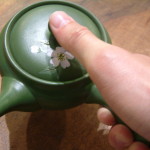After writing the prior blog on tea parties, I started looking at different recipes for cookies that are typically served with tea. Macaroons are mentioned, so I thought it would be fun to use Matcha instead of the green food coloring typically used in Pistachio Macaroons to make Matcha Macaroons. A traditional macaroon always contains nuts, usually almonds or pistachios. I was surprised to find that the matcha and pistachios got along just fine when it came to flavor. I filled these with chocolate buttercream to help soften the green tea taste of the cookies. However, you can make whatever buttercream filing you like to put in the middle of the cookies.
Matcha Macaroons
1/3 cup pistachios (these can be replaced with almonds)
2 tsps Matcha
3/4 cup powdered suger
2 large egg whites
1 tbs sugar
Chocolate Matcha Buttercream filling
1 stick of unsalted butter, room temperature
2oz semisweet chocolate, melted
1 tsp matcha
1 1/4 to 1 1/2 cup of powdered sugar
Grind the pistachios, powdered sugar and food processors until the nuts are as fine as the powdered sugar. You may need to stop and scrap the bowl down a couple of times to ensure you got as much of the nut pieces as small as possible. In a metal bowl, whisk the egg whites until fairly stiff and then dust them with the tablespoon of sugar. Then whisk until very stiff peeks forms. Fold into the egg whites the nut mixture about a quarter cup at a time. If the oil from the nuts causes the sugar to clump, just run the mixture through a sifter as you add it to the eggs to separate it. The mixture should be fully incorporated with the egg whites.
Pipe the mixture onto cookie sheets to get round circles. You will need either greased parchment paper or Siltpad in order to keep the cookies from sticking to the baking pan. The goal is to get an even number of cookies that are relatively the same size so we can incorporate the filling. If you do not have a piping bag and tips, just cut the corner off a ziplock bag and use that. They will not be as perfect, but still nicely round. You should get around 24-30 cookies depending on how big you make them. Bake for 8-12 minutes at 350 degrees Fahrenheit. Remove from oven and allow to cool on tray above a wire rack for at least 10 minutes before handling.
To make the filing, using an electric mixer beat the butter until pail and then add in the chocolate followed by the matcha and powdered sugar. The mixture will start to lighten in color and expand in the bowl as the sugar is incorporated. In judging whether to add additional sugar, look at the shininess of the cream and don’t be afraid to stop the blend and take a small taste. The filing needs to stay creamy, hold its form on the spoon (turn the spoon up-side down, if it starts to drop immediately you need more sugar) and not feel grainy on the tongue, which will happen if there is too much sugar added.
The filling can either be spooned onto the bottom of one cookie or piped on with an icing bag if you would like precision. An icing knife or straight edge can clean up the edges for you. Add around 1/2 tablespoon of the filing. Of course you can add more, it just may squeeze out the sides and become a bit messy when you bite in. (My six year old thinks this is one of the better features of this cookie). This will make somewhere around 12-15 cookies.












